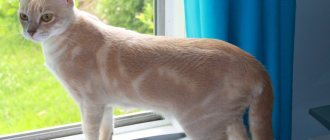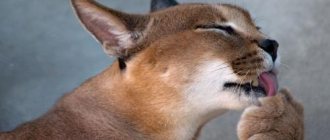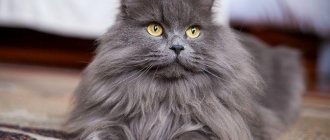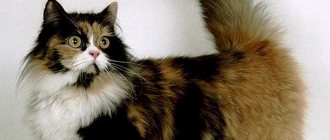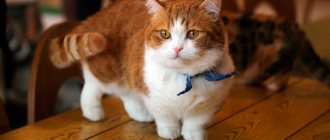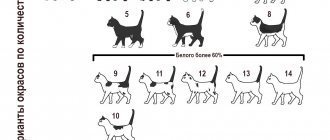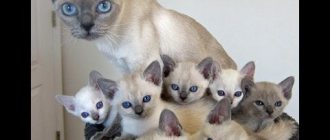The founder of the new breed of cats was Kiev felinologist Elena Biryukova. Ukrainian Levkoy is the fruit of her many years of work, which has been carried out since 2000. To create the breed, the Don Sphynx and Scottish Fold were crossed. The breed has only recently existed; in 2007, the first nursery for its representatives was created, but it has already managed to find its admirers.
Characteristics of this breed:
| Characteristic | Rating using a five-point system |
| Shedding intensity | 1 |
| Communication skills with people | 4 |
| Attitude towards strangers | 3 (complete indifference, without a bit of aggression) |
| Interaction with children | 4 |
| Activity level | 3 |
| Health status | 3 |
| Aggressiveness | 1 |
| The need to communicate with owners | 4 |
| Picky eating | 3 |
| Showing affection | 5 |
| Intellectual abilities | 4 |
| Need for care | 3 |
| Cleanliness | 4 |
| Maintenance cost | 4 |
| Get along with other pets | 5 |
| Need for clothing | 5 |
The breed is characterized based on statistical data and reviews from owners. These are average readings taken as a result of assessing the behavior of an individual representative. Therefore, individual differences are possible.
Levka without fur
Brief description of Levkoy cats
This is how you can briefly describe the Ukrainian Levkoy breed:
| Country of origin | Ukraine |
| Time of origin of the breed | 2004 |
| Lifespan | 12-14 years old |
| Average cat weight | 4-6 kg |
| Cat weight | 4-5 kg |
| Height at withers | About 25 cm |
| Body length with tail | 70-75 cm |
| The cost of a purebred kitten | 15-25 thousand rubles. |
| Price of an animal without documents | Up to 10 thousand rubles. |
Color genetics and breeding
The history of the Ukrainian Levkoy breed is distinguished by its youth; the first kitten was bred in Ukraine in 2004 from crossing the Don Sphynx, an Oriental cat, a Peterbald, a Scottish Ford and a domestic cat.
According to the standard, Levkoys can have any color, depending on the parental genetics. More often you come across cats with light milky or smoky shades.
The eye color of the Levkoy is striking in its richness and varied palette; blue or green are predominantly found.
To breed this breed, it is recommended to rely on a number of rules:
- in addition to similar ones, mating is allowed with a representative of the progenitor breed: Don Sphynx, Scottish Fold or Peterbald;
- breeding occurs according to a dominant trait (the lop-eared gene), so it is necessary that only one of them has drooping ears (crossing two lop-eared dogs can cause health problems in the future generation);
- Observe precautions: vaccinations, trimmed nails, mating in the male's territory.
The female's pregnancy lasts 60-65 days. Before giving birth, it is better to be vigilant, as there is a tendency for a dangerous disease - eclampsia.
In the question of how many kittens a Ukrainian Levko cat gives birth to, there is variability in the indicator, but on average a young cat gives birth to a litter of 3 (three) kittens.
Representatives of the Ukrainian Levkoy breed cannot be seen on the closet; for all their curiosity, they are afraid of heights.
Standards
Experimental breed of cats - Ukrainian Levkoy
These cats are truly unique in appearance. Even in the same litter there can be babies of different colors.
The main difference between purebred Levkoys is the lack of fur. It happens that fur is present in small quantities and then in isolated areas. Some have fur covering their entire body. Variations in color are also possible.
In any case, you need to focus on the established standard:
| Weight of cats | 6/4.5 kg (males are larger than females) |
| Head | Elongated, wedge-shaped, rectangular in shape. Well-defined cheekbones and arched eyebrows give the skull an angular appearance. The forehead is narrowed, with a smooth transition to the withers. The vibrissae cushions are dense, the vibrissae themselves are thickened and may be curled. |
| Ears | Wide set, wide, soft to the touch. At the tips they are slightly curved (in some left-handers they are straight). Usually they are pressed tightly to the head. Individuals with erect ears are called straights. |
| Eyes | In the form of tonsils, medium in size, slightly sloping and covered by the eyelid. The color of the iris is not important. |
| Frame | Rectangular-elongated, more massive in the rear. Well developed muscles. The chest is oval. The limbs are muscular, slender, strong with wide paws. The pads are oval with clearly distinguishable toes. |
| Tail | Relatively long, mobile, thicker at the beginning and tapering towards the end. |
| Skin covering | Silky and elastic to the touch, warm. There are folds throughout the body, especially on the head and ears. |
| Wool | Completely absent. However, some representatives may have a small fuzz. |
Hairless cat Levkoy
Disqualifying signs:
- rounded head;
- short nose;
- underdeveloped chin;
- weak eyelids;
- strabismus;
- underdeveloped skeleton.
Milakha
Levkoi are divided into varieties according to the intensity of their coat:
- bald;
- velor - wool up to 3 mm long;
- flock - edge up to 2 mm;
- brushpoint - sparse overgrowth;
- bristly brush - not allowed for exhibitions, but can be used for breeding.
Breed Features
The Ukrainian Levkoy, according to the WCF provisional standard, is a hairless cat whose unusual feature is lop ears. The body of the individual is medium in size, elongated, with good muscles. The animal is soft and hot to the touch.
Appearance
A detailed description of the Ukrainian Levkoy includes the following criteria:
- Head. It has the shape of an elongated wedge. The size is average. If you look from above, it will look like a pentagon with rounded outlines, longer than wide. The cranial area is impressive, the forehead is almost flat. The cheekbones are strongly pronounced and located high.
- Nose. Not long and not short, not wide. It features a smooth transition to the forehead and has a small step at eye level.
- Muzzle. Without sharp corners, rounded. The mustache may be absent, stiff or crimped.
- Eyes. They have an almond shape. Not completely open, slightly slanted. Can be of any shade.
- Ears. Widely located. In the middle part they have a forward bend. They can be almost pressed to the head or slightly raised.
- Torso. Medium size, strong, but not massive. Males are usually larger than females. The chest is oval-shaped, not wide, the back is slightly arched.
- Tail. Short and flexible.
- Limbs. Elongated and powerful. Paws are oval-shaped with long toes and webbed feet.
- Skin covering. There must be folds on it: between the ears, on the neck, in the groin area and under the armpits. Can be completely hairless or covered with fur up to 2 mm (flock type). Partial presence of vegetation on points (brush point type) is also allowed. Straight-haired and brush-coated dogs participate in breeding, but are not allowed for exhibitions. The color can be any.
The Ukrainian Levkoy has amazingly beautiful almond-shaped eyes and unusual forward-curved ears.
Character and behavior
Activity, devotion to people and sociability can be called the main character traits of Ukrainian Levkoys. In addition, these animals are extremely intelligent and easy to train. Thanks to these qualities, Ukrainian Levkoys can be called absolutely problem-free pets and ideal companions.
They easily get along with all household members and other pets. They are very attached to a person, constantly need his presence and communication - they can sit next to him or lie on his lap for hours. Levkoys are sensitive to changes in the mood and well-being of the owner. If the owner is preoccupied with something or feels unwell, the pet will not leave him a single step, will caress and purr until he considers that he has managed to correct the situation.
Ukrainian Levkoys get along well with other pets
Ukrainian Levkoys are unusually playful - they enjoy playing with various kinds of toys or actively spending time with children. They are not vindictive, not aggressive and rarely enter into conflicts.
Little lefties quickly get used to the tray. When visiting it, they behave very carefully - the owner will never see the filler scattered around. Pets are easy to train; if desired, they can be taught simple commands and tricks. It’s not for nothing that many compare their character and behavior to that of a dog.
Levkoys need to know that they are needed, the most important thing for them is the affection and attention of the owner. Loud, sharp sounds and violence are unacceptable for them, but the pets will enjoy the gentle praise of the owner or calm, soothing music. If a person treats the left-handed dog with attention and love, the animal will definitely respond in kind and will not create any problems.
One wise man said something like this: “It only takes a moment to be surprised, but it takes years to create something that can surprise.” It took a lot of time to create a cat with amazing appearance, friendliness and high intelligence. Before starting breeding, Elena Biryukova drew images of future cats on paper.
Video: Ukrainian Levkoy - all about the breed
Origin story
The Ukrainian Levkoy is a relatively new breed - bred in the 21st century. She owes her origin to felinologist Elena Biryukova. She set out to create completely original cats. Initially, I visualized my ideas in the form of pictures that I drew myself. Gradually I began to realize what exactly I wanted and what breeds could be used as primary sources.
Drawings by Elena Biryukova
The first baby appeared in January 2004 in the nursery owned by Biryukova, called Lada cats. He was christened Levkoy Primero. The kitten was without fur, with curled ears and huge eyes. The name for this breed was not immediately determined. The author saw in her charges certain traits from lions and dragons.
One day she saw a bud of gillyflower, whose petals were exactly like the ears of new cats. The name of the variety was instantly born.
After only 2 years, the original sample acquired multiple offspring - 40 representatives. A year later, these wonderful creatures took part in the WCF exhibition. At the same time, the first nursery for Levkoys appeared. In 2010, hairless cats could already participate in the Ukrainian championships using the ICFA RUI strategy.
Ukrainian cat at an exhibition
Despite the fact that the International Organization of Felinology has not yet recognized this species of feline, seals have gained popularity in many countries.
In 2012, the WCF officially introduced the Levkoy as an independent breed and developed a preliminary standard.
Price depending on region
If we consider how much a kitten costs, then the price in Russia varies - from 5 to 35 thousand rubles. Depends on class, gender, hairless or “brush” type (with curly hair), fold-eared (fold) or straight-eared (straight).
A review of the market for the sale of Ukrainian Levkoy kittens showed the following figures:
| City | Price, rub |
| Moscow | 10-35 thousand |
| Saint Petersburg | 7-25 thousand |
| Rostov-on-Don/ Krasnodar | 5-15 thousand |
| Vologda | 10 thousand |
| Samara | 5-10 thousand |
| Smolensk | 5-10 thousand |
| Khabarovsk | 5-20 thousand |
| Ufa | 10-15 thousand |
Levkoy colors
The standard does not establish clear boundaries for animal colors. They are different: solid, patterned, spotted. The coloring of babies is determined by the color of their parents. Kittens of light and smoky shades are common, and saffron milk caps are sometimes found. The monochromatic colors include:
- resinous - looks like a grayish slate, darker paw pads and an almost black nose;
- blue - light black, with a bluish sheen, with light gray pads and the same nose;
- chocolate - all shades of brown, paw pads - light cream, nose - the same as the base color;
- lilac - cold silver with a pinkish inclusion, pillows and nose - lilac-pink;
- scarlet - fiery red color with clear stripes and spots throughout the body (as cats grow older, they shade);
- creamy - light scarlet shade, pads and nose - pinkish (cream cats, when mated with cats of different colors, give tortoiseshell offspring);
- snow-white - without any inclusions, pads and nose - pink, eyes - blue or different.
White
Of the common colors, they also note:
- Tabby - there are stripes and spots; in the neck, belly and inside the paws the tone is lighter with a lemon tint. The nose is pink with a dark border. There are tabbies: black, chocolate, blue.
- Bicolor is a combination of the main color and snow-white. The colored areas stand out against the white background (they occupy about a third of the body). One ear is stained, there may be a white spot on the head. There is a white streak on the tail.
Gray - white
Character of the breed
These are surprisingly loving creatures. They are flexible in nature and loyal to their owner. They live well in the neighborhood with other small domestic animals, behave well with children, and do not shy away or show aggression towards strangers in the house. Hairless cats prefer to spend most of their time on their knees.
There is no aggression at all from them, they are the embodiment of kindness and tenderness. Excessive curiosity encourages these tomboys to participate in all everyday activities. Cats are highly intelligent, so they are easy to train and learn quickly. They can independently analyze what is happening and get out of problematic situations with dignity.
very playful creatures
take root in a new place without any problems and quickly understand where to go to the toilet. They are clean from birth, so they never scatter the contents of the tray around.
They immediately understand where they need to sharpen their claws and will not damage furniture or carpets.
These are determined animals who will not doubt their actions. If they need communication, they will come up and touch you with their paw. They can listen, sometimes responding with meows. Therefore, it is an ideal companion for older people. They enjoy participating in outdoor games with children.
In the basket
In terms of devotion to humans, they are similar to dogs. Kitties sense the mood of the owner and will not impose themselves if it is not up to them. They love to walk outside, but due to their bare skin, long walks are fraught with colds.
Their excessive curiosity and restlessness pushes them to explore everything new on the street - they may even taste flowers. At home, everything that breaks must be put away, otherwise the pet, in the excitement of the game, will definitely break or break something. Levkoys do not climb cabinets because they are afraid of heights.
Turned away
Caring for Ukrainian Levkoys
You need to prepare in advance for the arrival of a new resident. It is recommended to remove away objects that pose a danger to the baby. This also applies to values. Plants can also fall into the field of interest of this inquisitive creature, so they are moved higher. Protective nets are installed on the windows so that they hold well and the left-handed one cannot handle them.
If you have a balcony without glass, you need to limit your pet's access there.
like a hare)
Be sure to purchase the necessary accessories:
- sleeping area;
- scratching post;
- bowls for food and drink;
- litter tray;
- all kinds of toys;
- cosmetics, clothes;
- carrying.
Bathing training
It is necessary to accustom your cat to hygiene procedures from an early age. In animals with fluffy fur, the oil produced by the sebaceous glands spreads throughout the fur. Hairless cats accumulate it on their skins. When there is an excess of it, a specific smell appears and the animal begins to dirty things.
Well, let's go swimming
To avoid such an incident, it is necessary to wipe the Levkoy’s skin every day with a damp cloth (without alcohol). Once every 7-8 days you can bathe the tomboy using a specialized shampoo. After the bath, wipe it with a terry towel and apply baby cream to moisturize the skin.
Eye care
Eyes need daily care. They should be wiped with damp wipes or feet, after soaking them in zoo balm. If there is heavy discharge, you should immediately consult a veterinarian. If they are completely absent, then you also need to show your pet to a doctor.
Favorite pet
Ears
The ears are examined 2-3 times a month. Systematically treat the inside of the sink with moistened cotton swabs or disks (chlorhexidine solution is suitable). The floppy ears of left-handed cats quickly become dirty. And the accumulation of sulfur and dust is fraught with inflammatory processes.
Fold
Teeth
Dental care for cats is mandatory. From an early age they begin to have problems with them: plaque on the teeth leads to the formation of tartar, pulpitis and periodontitis. Cleaning paste can be purchased in specialty stores (human ones cannot be used). A brush, suitable for children with soft bristles (slightly shorten it).
Sharp teeth
Claws
Claws are trimmed regularly. You only need to cut off the light part, since the pink part contains small vessels. The claws grow quite intensively, which is already dangerous for people. Therefore, it is recommended to cut them 1-2 times a month, as well as before exhibition shows, mating and after childbirth.
With claws
Nose
It is advisable to check your nose every 2 days. Wipe it no more than once a week. To do this, take a damp cloth. If there is discharge, contact a veterinarian.
small nose
Cloth
It is better to take care of clothes for left-handed people when the room temperature drops below 22-23 degrees. They also dress the pet when walking, regardless of the season. In summer, a thin cape made of cotton fabric is enough to protect against ultraviolet radiation. In winter you will need an insulated overall, shoes and a hat. The seams on clothing should be on the outside.
Levka in beautiful clothes
It is not recommended to take your cat for a walk in cloudy weather with rain. Even the presence of a raincoat will not protect you from moisture and there is a high probability of catching a cold.
To prevent the lefty from catching a cold while walking
Diet
Levkoys have an accelerated metabolism, so they do not suffer from lack of appetite. Contrary to this, they are not omnivores. You should not feed them from the common table. A balanced diet is required, according to a specific schedule. Overeating is fraught with problems with the digestive system.
You can feed your pet both ready-made food and natural food (choose one or the other). If you choose the second option, then you should cook it separately. They give food three times a day. The menu should include the following:
- meat (turkey, rabbit, chicken, veal);
- liver, stomachs, necks, heart;
- fish without small bones (sea);
- sour milk (cottage cheese, kefir, cream);
- chicken eggs (once a week);
- fresh vegetables (cabbage, carrots, zucchini);
- various cereals (rice, buckwheat, millet);
- greenery.
It is forbidden to give your cat fatty meat, various seasonings, garlic, onions, sausages, smoked meats, canned food, potatoes, noodles, spicy and fried foods.
Ukrainian Levkoy with wool
If preference is given to industrial feed, pay attention to the composition. It must contain vitamins and microelements. It is not recommended to save money in this matter and buy only premium food. The cat should be provided with free access to clean drinking water.
Recommended food
Dry food has many advantages. They have a balanced composition, portions are easily calculated according to the weight of the animal, are stored for a long time and save time. In addition, the assortment includes a variety of lines: for castrated (sterilized), sick cats and others.
You should choose food not according to advertising, but according to common sense. Thus, the compositions of the brands Perfect Fit, Wellkiss, Whiskas and “Our Mark” are budgetary, which include meat waste, ingredients of plant origin, and few minerals and vitamins.
Premium category food is much better in composition. These are the brands Brit Premium, Blitz, Eukanuba, “Night Hunter”. They contain wheat and corn (a carbohydrate source), natural meat, and antioxidants. But super-premium food is expensive, but also of the highest quality. These are: Dr Сlauder's, Landor, Guabi Natural, Karmy, Pronature Original.
Care
Due to the youth of this breed and insufficient knowledge, the care and maintenance of Ukrainian Levkoys requires serious attention. In addition, the hairless cut requires compliance with certain rules in life.
Initially, you should rely on the following recommendations, adapting them to suit your pet in the process:
- keep lefties at a warm room temperature because they are sensitive to cold, like other hairless cats (such as Sphynxes or Peterbalds);
- keep the humidity comfortable, without dry air;
- Avoid direct sunlight (UV can cause burns);
- provide sufficient fluids to prevent dehydration (fraught with skin problems);
- in nutrition, it is better to prefer dry food according to a regimen, carefully monitoring weight balance and hiding tasty additions that can be absorbed in unlimited quantities (prone to obesity);
- delicate eye care;
- due to abundant skin secretions, the breed requires regular wet cleaning (special wipes, bathing);
- such cats are at risk of injury; Nails must be trimmed regularly.
In appearance, the Ukrainian Levkoy resembles an alien creature. And this makes sense: dialogue with such a pet through eye-to-eye contact perfectly relieves headaches, nervous tension, cleanses the mental plane, making room for clear thoughts and inspiration.
Diseases and vaccinations
It is recommended to learn about possible genetic defects and predispositions to certain diseases. By how an animal behaves, you can understand its health status. If the baby is apathetic and not very active, it means he is not doing so well. If he is still meowing, he is probably in pain.
a bit large
Levkoys have the following health problems:
- a congenital defect called “bent ear” - underdeveloped ears (manifests in the fourth week of life);
- “twisted ear” defect - when the tips are bent back;
- denovo - there are folds in the shells of the ears, and the ears, curved at the ends, puff up on the sides;
- “cleft palate” - curvature of the jaw;
- blood pathologies;
- eye diseases;
- problems with the digestive tract;
- neurology.
cat sailor
Levkoys have a predisposition to the following diseases:
- neoplasms;
- mastitis;
- uterine hernia;
- hypovitaminosis;
- rabies;
- violation of metabolic processes;
- leukemia;
- worms.
To avoid dermatitis with eczema, you need to carefully care for your cat's skin. Even the slightest wounds are treated with a special solution. Levkoys are also prone to colds, although they have an elevated skin temperature.
With different ears
Cats should be vaccinated on time to prevent diseases. Then the animal will have strong immunity. The first vaccine is given at 2 months, the next one is given a couple of weeks later. This is followed by vaccination at six months of age and one year. Then you need to be vaccinated once a year. 10 days before such a procedure, it is necessary to worm your pet.
Lifespan
With proper care, the animal can live up to 13-14 years. The main thing is to monitor the condition and at the slightest deviation from the norm, contact a veterinarian.
Adult lefty
Breeding
After mating, pregnancy can only be diagnosed at 3-4 weeks by looking at swollen nipples. It lasts 65 days in cats. By the end of the second month, the cat is gaining significant weight, and milk appears in the nipples. Toxicosis is possible - just like in humans.
During this period, the pet needs special care. Be sure to give additional vitamins (in particular, calcium and protein). It is advisable to consult a veterinarian about the choice of mineral complex. He will probably advise you to switch to specialized food.
Very small
Even before giving birth, you need to make a comfortable place for the animal. The box is lined with yarn. Usually the cat copes with childbirth on its own, but in extreme cases outside help may be required.
15-20 minutes after the baby is born, the woman in labor gnaws the umbilical cord and removes the amniotic sac. If she does not do this, the owner should take the kitten out and cut the umbilical cord himself, stepping back 2-2.5 cm from the belly. If there are numerous offspring, the mother should not be allowed to eat the entire afterbirth - this can lead to poisoning.
Brothers
What to prepare for a kitten
Before you bring the kitten home, you need to prepare the apartment a little.
To begin with, they conduct an audit of indoor plants, removing all poisonous ones - the kitten may feast on them out of curiosity. Then, if necessary, install screens on the windows. The nets must be held very tightly, otherwise the cat will easily squeeze them out and may fall out of the open window.
What you need to purchase and prepare for a new family member:
- Sleeping area
- A scratching post that has been taught since childhood
- Tray and filler (preferably the same as the breeder's, so that the kitten gets used to it faster)
- 2 bowls if you plan to feed dry food and 3-4 if natural
- Toys
- Special scissors. It is necessary to trim the claws once every 3-4 weeks, this is done very carefully - the part of the claw, painted a slightly pinkish color, already has blood vessels
- Special shampoo, soft washcloth and towel
- Soft brush with natural bristles for velor gesso
- Skin care products
- Special toothbrush.
The skin of all hairless cats is very delicate and therefore requires careful care. If the air is dry, especially during the heating season, your skin may dry out and peel, so you may need to purchase a humidifier. Levys can get sunburned easily in the summer, so don't let your pet stay in direct sunlight for too long.
Advantages and disadvantages
Almost no one will be able to remain indifferent once they get to know this amazing creature better. His complaisance and loving nature will conquer anyone. The advantages of Levkoy include:
- unique appearance;
- high IQ, quick learner;
- obedience, affection;
- playfulness;
- friendliness;
- communication skills.
My charm
There are also disadvantages:
- lack of independence;
- dependence on the owner;
- special care;
- secreted skin secretion that stains everything;
- predisposition to colds;
- loud meow.
The good-natured and humble disposition of a hairless cat allows her to easily take root in any home. Some people are not satisfied with the unusual appearance of their pet: no eyelashes, mustache, or fur. Some people find excessive sweating annoying.
If you do not wipe your skin for a long time, the discharge becomes oily and dark. Then the cat begins to dirty everything it touches. Plus, it smells bad.
Castration and sterilization
Castration and sterilization of Ukrainian Levkoys is resorted to by owners who do not plan to get offspring, and also do not want to experience unpleasant moments associated with the animal’s sex life . Both operations, differing in the mechanism of implementation, deprive the animal of the ability to produce offspring.
The most popular procedure is castration. It is optimally carried out between the ages of 6 and 14 months. Surgical procedures take no more than 15 minutes and are performed under anesthesia. Complications after surgery are extremely rare, and the recovery period takes no more than two weeks. At this time, it is necessary to protect the pet from hypothermia, make sure that it does not show excessive activity, and treat the seams with brilliant green.
Castration does not have any negative impact on the health and quality of the pet's future life. On the contrary, the animal becomes calmer and more affectionate. In addition, after surgery the risk of some serious pathologies is reduced.
How much do kittens cost?
It is recommended to buy baby Levkoys from professional nurseries, and not from dubious advertisements. First you need to study the breed standard. The price depends on the breed. So, in one litter there can be kittens worth from 10 to 25 thousand rubles.
Levkoy kittens cost differently, depending on their breed
A separate item are lefties with straight ears - called “straights”. The price for them is less than for left-handers with a standard appearance.
How to choose a kitten
Undoubtedly, in order to buy a purebred kitten, you will have to contact a Ukrainian Levkoy nursery. If a kitten is purchased as a pet, you can be guided only by personal sympathies, but if you want to start breeding, carefully read the breed standards.
Important! Be sure to ask the breeder about the specifics of caring for and feeding your little Levkoy! Cats of this breed have fairly good health, but require special care for their skin, ears and eyes, as well as a competent approach to nutrition.
The price of a Ukrainian Levkoy kitten is quite high - on average from 15 to 20 thousand rubles. It will depend on gender, fold ears, presence or absence of hair, and compliance with breed standards.
Interesting Facts
Despite the fact that the history of the breed began in Ukraine, the first nursery for this breed opened in Russia. Today thousands of Ukrainian Levkoys live there. Cats are already eligible to participate in shows and receive awards, although the breed has not yet received official status.
Ukrainian cat
Owners of such cats say that their skin is very silky and soft to the touch, like a baby’s. The body temperature of left-handed cats is much higher than that of other felines - 40 degrees. Therefore, when you touch them, it seems that they have a fever. And due to the fact that there is no fur, even minor flaws are noticeable on the skin. But this is good for those who are allergic to cat fur.
With a teddy bear
It is easy to distinguish males from females - the former are larger and much larger. Another interesting fact about the Levkoy: the founder of the species made sketches on paper for several years before she received the ideal cats for the new breed. The standard does not provide for restrictions on the colors of hairless kitties. Various colors are acceptable.
Lefty litter
Since ancient times, these hairless creatures have been revered in Egypt. They were considered sacred animals and had certain magical powers. It was assumed that the cats gave their clothes to their owner to save him from the cold. And in return, higher powers awarded cats with high warm-bloodedness.
new breed
Appearance and physique
This cat breed is truly unique and cannot be confused with any other. But, despite this, lovers of Ukrainian Levkoys (and not only) need to know the standard breed data of the animals:
- The body of cats of this breed is well developed, it is not large, but muscular. The limbs are long and strong, and the paws are oval in shape. The tail of the Levkoy is flexible and very long.
- The head is medium in size, slightly angular, long and flat. The ears are set wide apart; cats can be fold-eared (folds) or straight-eared (straight). The animals' eyes are large and almond-shaped. Eye color can be any.
- Ukrainian Levkoys are hairless animals. Their body is hot and folded. Cats can be of different colors.
Differences between Levkoys and other similar breeds
These cats have some similarities with some similar breeds. Therefore, it is worth finding out the main differences.
Don Sphynx
The highlight of the Don Sphynx is its large, smooth, erect ears. According to the constitution, Levkoi are larger than Sphinxes (weight 3 - 4 kg). Also, their chest is not as wide. Sphynxes have more graceful limbs.
The breeds are similar in that both have hairless varieties and those with fur.
Canadian Sphynx
They are almost identical in size, but the Sphynx is more muscular. Their ears are erect, much larger than those of Levkoys. Another difference is the protruding round tummy, which is present even in specimens with normal body weight.
Canadian Sphynx cats have pinkish fluff on certain parts of their bodies.
Kohana
These animals have no hair at all due to underdeveloped hair follicles. They have folded skin and straight ears. They are also smaller in build.
Folded, hairless cats are kohans
Bambino
The main difference between Bambino and Ukrainian Levkoys is their shortened paws.
Squat hairless cats
Elf
Elves have ear tips that bend back. This is their main difference from Levkoy.
These cats look like a fairy tale character
Oriental
These are representatives completely covered with hair. They have straight ears and a tucked belly, which is not typical for Sphinxes and Levkoys.
Lop-eared cats
Peterbald
This animal stands out for its excessive “talkativeness”. It has a profile similar to that of a snake. The ears are long and erect. The overall impression of the figure is elegant and graceful.
Peterbald cat breed
It’s worth mentioning right away that you need to purchase Ukrainian Levkoys from specialized nurseries, and not from random advertisements. Many unscrupulous sellers pass off similar breeds as Levkoys, having first shaved the animal. This cat breed is unusual in itself and requires special care and attention. But all efforts will be returned with interest in the form of devotion and love of the pet.
Before you start such a creature at home, you need to evaluate your strengths. Cats cannot stand being alone, so they should not be left for long periods of time. Their advantage is that they do not cause allergies.
Interesting video:
Purchasing a kitten
To protect yourself from unpleasant surprises, it is best to purchase a Ukrainian Levkoy kitten from nurseries with a positive reputation. Before you take a responsible step, you should study the breed standards. If a pet is purchased simply for the soul, then when choosing, you can rely on intuition and personal sympathies.
The kitten must be healthy, friendly and active. A visual examination will help to assess his physical condition - a healthy baby should not cough or sneeze or itch. His eyes and ears should be clean, his gums should be healthy, his skin should be smooth and soft, without dry areas or redness. The tummy should be round, but not bloated.
If it is assumed that the animal will participate in exhibitions, then it is necessary to assess whether its appearance meets the standards. The structural features of the head are among the main breed characteristics. Its shape should be wedge-shaped, the cheekbones and brow ridges are clearly defined. The muzzle is not too elongated in length, the chin and jaw should be well developed. A prerequisite is the presence of folds on the head, neck, armpits and groin.
There must be folds on the skin of a Ukrainian Levkoy kitten - on the neck, head, armpits and groin.
At what age is it better to buy
Not a single truly competent and loving breeder will give away a cub before it turns 3 months old. It is by this time that the animal is ready for independent life; it has received all the necessary vaccinations.
Drawing up a purchase and sale agreement is a prerequisite for purchasing a purebred kitten. The breeder must also provide the owner with a birth certificate, pedigree and veterinary passport.
Completely hairless kittens are much more expensive than those covered with light fluff. But those with a brush type of coat at birth are likely to “undress” with age.

